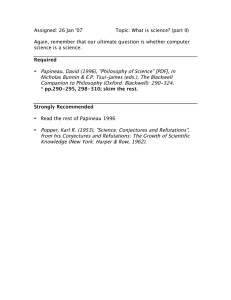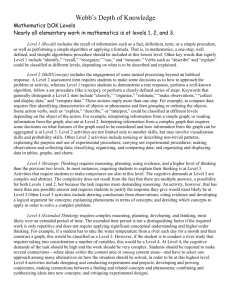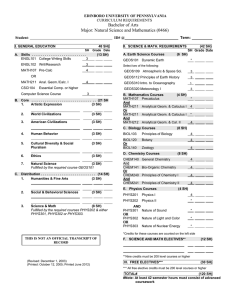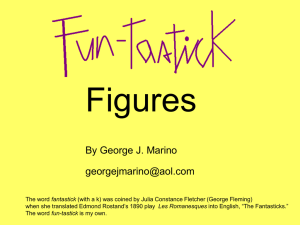Westside High School Lesson Plan
advertisement
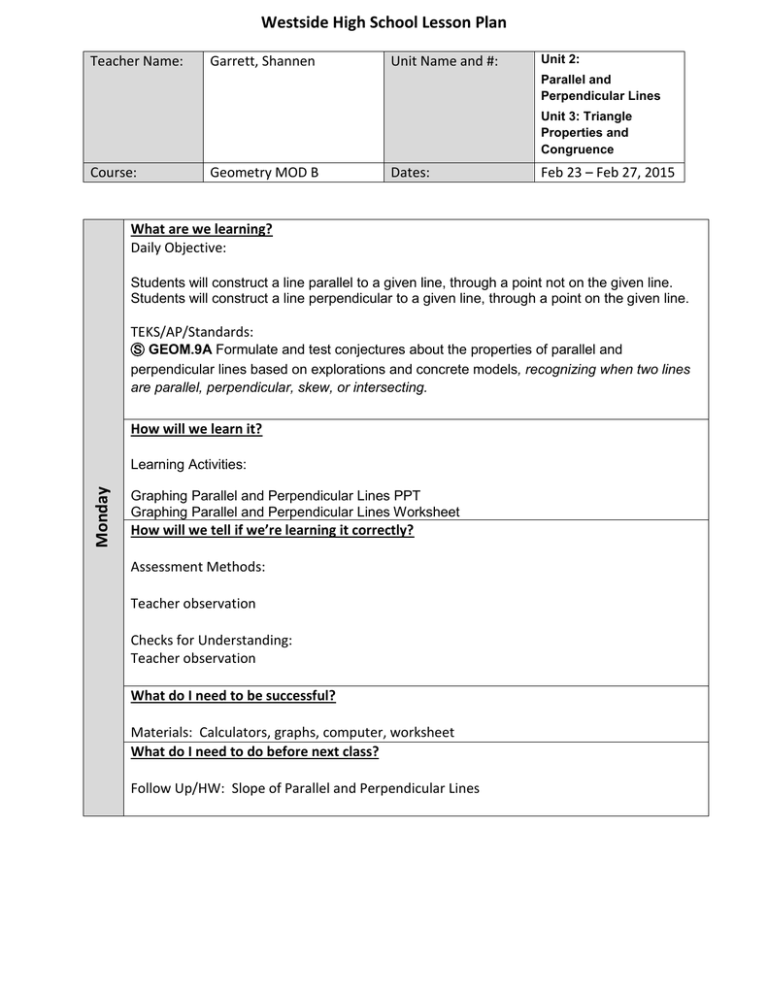
Westside High School Lesson Plan Teacher Name: Garrett, Shannen Unit Name and #: Unit 2: Parallel and Perpendicular Lines Unit 3: Triangle Properties and Congruence Course: Geometry MOD B Dates: Feb 23 – Feb 27, 2015 What are we learning? Daily Objective: Students will construct a line parallel to a given line, through a point not on the given line. Students will construct a line perpendicular to a given line, through a point on the given line. TEKS/AP/Standards: Ⓢ GEOM.9A Formulate and test conjectures about the properties of parallel and perpendicular lines based on explorations and concrete models, recognizing when two lines are parallel, perpendicular, skew, or intersecting. How will we learn it? Monday Learning Activities: Graphing Parallel and Perpendicular Lines PPT Graphing Parallel and Perpendicular Lines Worksheet How will we tell if we’re learning it correctly? Assessment Methods: Teacher observation Checks for Understanding: Teacher observation What do I need to be successful? Materials: Calculators, graphs, computer, worksheet What do I need to do before next class? Follow Up/HW: Slope of Parallel and Perpendicular Lines What are we learning? Daily Objective: Students will be able to determine the definition of similarity. Students will be able to determine the definition of congruency. Students will be able to determine the requirements for similarity. Students will be able to determine the requirements for congruency TEKS/AP/Standards: Ⓡ GEOM.2B Make conjectures about angles, lines, polygons, circles, and three-dimensional figures and determine the validity of the conjectures, choosing from a variety of approaches such as coordinate, transformational, or axiomatic. Ⓢ GEOM.3D Use inductive reasoning by collecting information and finding patterns to formulate conjectures. Ⓢ GEOM.3E Use deductive reasoning to prove a statement. Tuesday How will we learn it? Learning Activities: Classifying Geometric Shapes and Objects Pre-Assessment o Students will sort cards using properties and characteristics of figures and objects on their cards and will record their sorting on a table How will we tell if we’re learning it correctly? Assessment Methods: Teacher observation Checks for Understanding: Teacher observation Students will share with another person What do I need to be successful? Materials: Calculators, graphs, computer, What do I need to before next class? Follow Up/HW: What are we learning? Daily Objective: Students will be able to determine the definition of similarity. Students will be able to determine the definition of congruency. Students will be able to determine the requirements for similarity. Students will be able to determine the requirements for congruency TEKS/AP/Standards: Ⓡ GEOM.2B Make conjectures about angles, lines, polygons, circles, and three-dimensional figures and determine the validity of the conjectures, choosing from a variety of approaches such as coordinate, transformational, or axiomatic. Ⓢ GEOM.3D Use inductive reasoning by collecting information and finding patterns to formulate conjectures. Ⓢ GEOM.3E Use deductive reasoning to prove a statement. How will we learn it? Wed/Thur Learning Activities: Using geoboards or dot paper, students will create as many congruent shapes as possible Using geoboards of dot paper, students will create as many noncongruent shapes as possible CatchUp Math How will we tell if we’re learning it correctly? Assessment Methods: Teacher observation Checks for Understanding: Teacher observation Student sharing What do I need to be successful? Materials: Geoboards, dot paper, pencils, math journals, straight-edge, rulers, protractors What do I need to before next class? Follow Up/HW: What are we learning? Daily Objective: Students will be able to determine the definition of similarity. Students will be able to determine the definition of congruency. Students will be able to determine the requirements for similarity. Students will be able to determine the requirements for congruency TEKS/AP/Standards: Ⓡ GEOM.2B Make conjectures about angles, lines, polygons, circles, and three-dimensional figures and determine the validity of the conjectures, choosing from a variety of approaches such as coordinate, transformational, or axiomatic. Ⓢ GEOM.3D Use inductive reasoning by collecting information and finding patterns to formulate Friday conjectures. Ⓢ GEOM.3E Use deductive reasoning to prove a statement. How will we learn it? Learning Activities: Diagonals of Quadrilaterals How will we tell if we’re learning it correctly? Assessment Methods: Group work – students make and list conjectures about the diagonals of different quadrilaterals. Students will share out. Checks for Understanding: Teacher Observation, student discussion, math journal What do I need to be successful? Materials: Math journal, straight-edge, rulers, protractors What do I need to before next class? Follow Up/HW:
